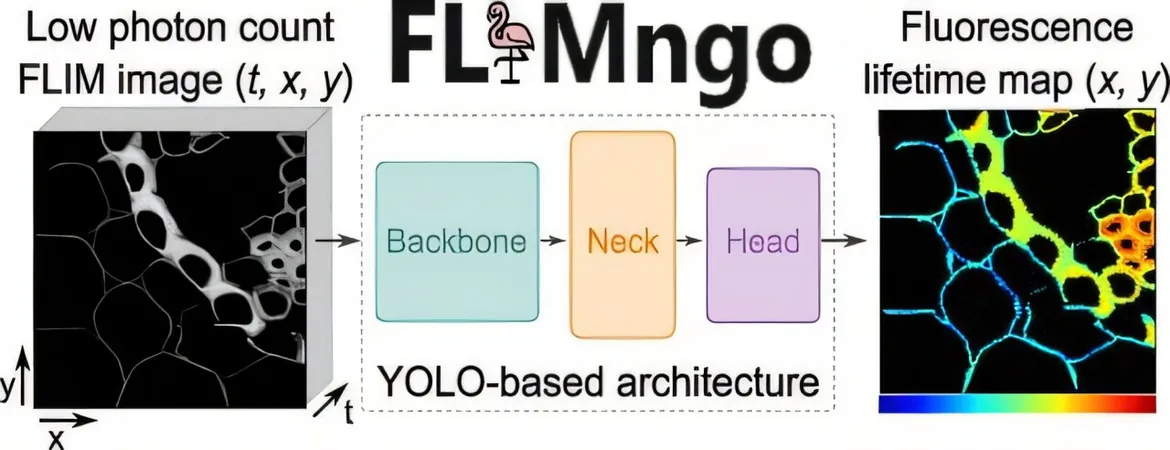
Revolutionizing Biomedical Imaging: New AI-Powered Open-Source Tools
2025-07-09
Author: Daniel
Introducing Game-Changing Tools for Biomedical Imaging
In an exciting breakthrough for fluorescence lifetime imaging microscopy (FLIM), two open-source tools promise to transform the landscape of biomedical imaging, making it faster, simpler, and more accessible. These innovations, crafted by Ph.D. student Sofia Kapsiani under the expert guidance of Professor Gabi Kaminski Schierle, are designed to dismantle long-standing technical challenges in the field.
Meet FLIMPA and FLIMngo: Your New Imaging Best Friends
Taking a dual approach to improving imaging efficiency, Kapsiani has developed two groundbreaking tools: FLIMPA and FLIMngo. FLIMPA is an advanced phasor analysis software, while FLIMngo is a deep learning model that drastically reduces data acquisition time. Together, they tackle major obstacles in FLIM, including slow imaging speeds and the high costs associated with proprietary software, offering researchers greater flexibility in live imaging and healthcare studies.
Swift Data Collection with FLIMngo
FLIMngo shines in its ability to dramatically shorten the time required to gather FLIM data. Trained to work with minimal photon counts, this state-of-the-art model can analyze in vivo images in just seconds while maintaining accuracy. This enhancement not only accelerates the FLIM process but also minimizes light exposure and phototoxicity—critical factors for live sample studies. Kapsiani demonstrated its efficacy by following protein aggregates linked to diseases in *C. elegans* without the need for anesthesia.
FLIMPA: Open-Source and User-Friendly
Earlier in the rollout, the analytical gem FLIMPA was introduced, providing a free, open-source standalone tool for phasor analysis. Compatible with diverse file types and equipped with advanced visualization features, FLIMPA boasts an intuitive interface, enabling researchers to analyze multiple samples and scrutinize molecular behaviors with ease. Kapsiani employed FLIMPA to develop a novel cell-based assay that quantifies microtubule depolymerization, a critical aspect of anti-cancer drug research.
A New Era for Live Imaging Research
As Professor Kaminski Schierle aptly noted, “These tools exemplify what happens when deep technical understanding meets creativity and curiosity.” With Kapsiani’s groundbreaking work, FLIM is on the verge of becoming a more accessible and scalable tool for researchers everywhere, breaking free from its previous niche status.
The Future of Biomedical Imaging is Here!
These innovative tools herald a new era in biomedical imaging, where researchers can navigate complexities with unprecedented ease. FLIMPA and FLIMngo are set to revolutionize the way we visualize and understand the intricacies of live organisms, paving the path for future discoveries in health and medicine.




 Brasil (PT)
Brasil (PT)
 Canada (EN)
Canada (EN)
 Chile (ES)
Chile (ES)
 Česko (CS)
Česko (CS)
 대한민국 (KO)
대한민국 (KO)
 España (ES)
España (ES)
 France (FR)
France (FR)
 Hong Kong (EN)
Hong Kong (EN)
 Italia (IT)
Italia (IT)
 日本 (JA)
日本 (JA)
 Magyarország (HU)
Magyarország (HU)
 Norge (NO)
Norge (NO)
 Polska (PL)
Polska (PL)
 Schweiz (DE)
Schweiz (DE)
 Singapore (EN)
Singapore (EN)
 Sverige (SV)
Sverige (SV)
 Suomi (FI)
Suomi (FI)
 Türkiye (TR)
Türkiye (TR)
 الإمارات العربية المتحدة (AR)
الإمارات العربية المتحدة (AR)